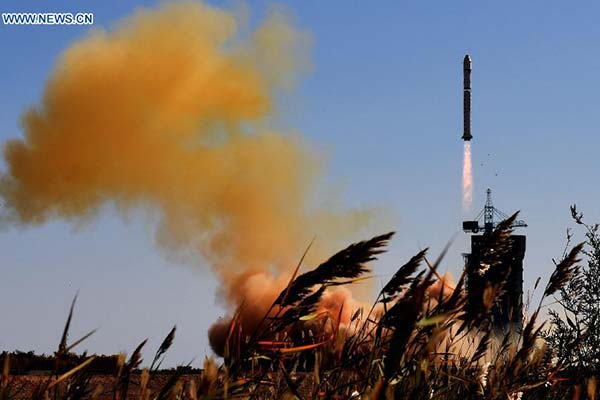 |
|
A Long March-2D carrier rocket carrying the "Jilin-1" satellites blasts off from the launch pad at the Jiuquan Satellite Launch Center in northwest China's Gansu province, Oct 7, 2015. [Photo/Xinhua] |
China's largest missile manufacturer plans to use its solid-fuel rockets to tap into the international commercial launch market, said a senior rocket designer.
Hu Shengyun, who heads solid-fuel rocket development at the Fourth Academy of China Aerospace Science and Industry Corp, said his company is considering founding a company dedicated to providing commercial launches for domestic and international clients.
Hu, also a national lawmaker, said the new company would break the monopoly by China Great Wall Industry Corp, which is currently the nation's only authorized provider of commercial launch service.
China Aerospace Science and Industry Corp began to develop Kuaizhou solid-fuel rockets in 2009, intending to form a low-cost, quick-response rocket family for the commercial launch market.
China has launched 53 Long March rockets to carry 61 satellites into space for 24 foreign clients.
"There are at least 50 domestic institutes and companies involved in the development of small and miniaturized satellites, but they have to wait a long time to have them launched," the scientist said. "This is because State-funded satellites always have priority in launch scheduling. Moreover, many small developers can't afford the high expenditure," he told China Daily.
Globally, many space companies are seeking reliable, low-cost launch vehicles to lift their small satellites, and this represents a huge business opportunity for Kuaizhou rockets.
The first flight of a Kuaizhou rocket took place in September 2013, when the company launched the Kuaizhou 1 at the Jiuquan Satellite Launch Center in northwest China to put an Earth observation satellite into orbit. In November 2014, the Kuaizhou 2 sent another satellite into space from the same launch center.
Currently, the Fourth Academy is making the Kuaizhou 11 and plans to launch it around 2017, according to Hu.
Compared with Kuaizhou 1 and Kuaizhou 2, the Kuaizhou 11 will have a larger diameter and stronger capacity. It will be able to place a 1-metric-ton payload into a sun-synchronous orbit at an altitude of 700 kilometers.
Prelaunch preparations will take very little time, and the launch can be conducted on rough terrain, Hu said.
"We estimate that by 2020, the market value of commercial space activities in China will reach 30 billion yuan ($4.6 billion) each year. We plan to produce up to 30 Kuaizhou solid-fuel rockets annually if our business goes well," the designer added.
The United States has converted its Minuteman and Peacekeeper intercontinental ballistic missiles into Minotaur solid-fuel rockets, using them to serve military and commercial purposes.
In addition, the Italian Space Agency and European Space Agency have developed the Vega solid-propellant system and have conducted six launches.
